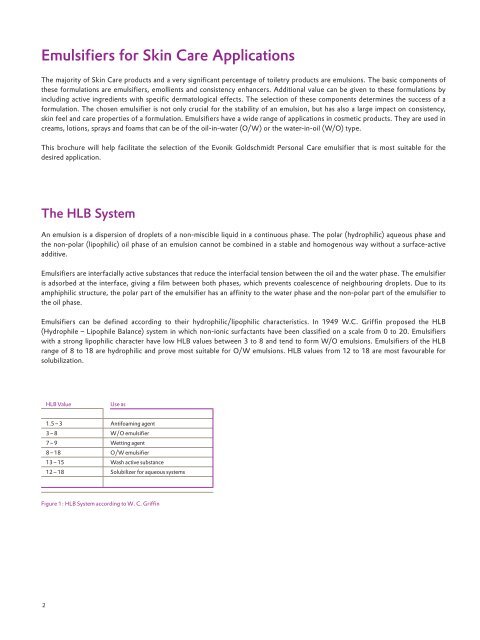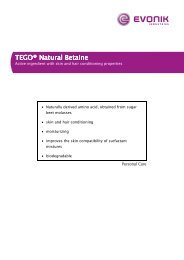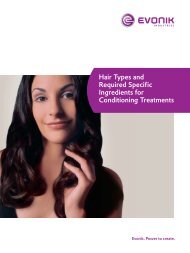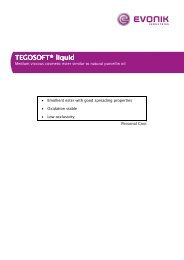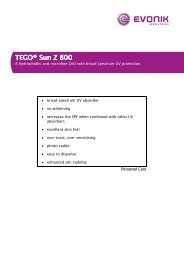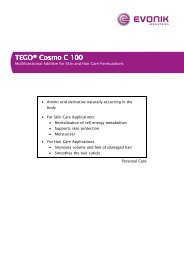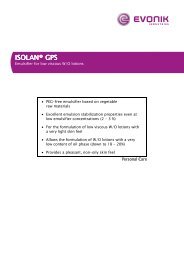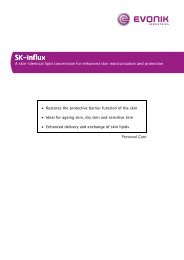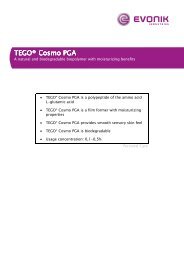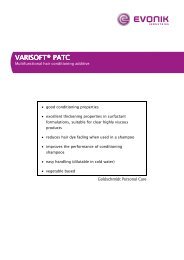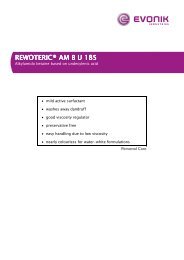Emulsifiers for Skin Care Applications
Emulsifiers for Skin Care Applications
Emulsifiers for Skin Care Applications
Create successful ePaper yourself
Turn your PDF publications into a flip-book with our unique Google optimized e-Paper software.
<strong>Emulsifiers</strong> <strong>for</strong> <strong>Skin</strong> <strong>Care</strong> <strong>Applications</strong><br />
The majority of <strong>Skin</strong> <strong>Care</strong> products and a very significant percentage of toiletry products are emulsions. The basic components of<br />
these <strong>for</strong>mulations are emulsifiers, emollients and consistency enhancers. Additional value can be given to these <strong>for</strong>mulations by<br />
including active ingredients with specific dermatological effects. The selection of these components determines the success of a<br />
<strong>for</strong>mulation. The chosen emulsifier is not only crucial <strong>for</strong> the stability of an emulsion, but has also a large impact on consistency,<br />
skin feel and care properties of a <strong>for</strong>mulation. <strong>Emulsifiers</strong> have a wide range of applications in cosmetic products. They are used in<br />
creams, lotions, sprays and foams that can be of the oil-in-water (O/W) or the water-in-oil (W/O) type.<br />
This brochure will help facilitate the selection of the Evonik Goldschmidt Personal <strong>Care</strong> emulsifier that is most suitable <strong>for</strong> the<br />
desired application.<br />
The HLB System<br />
An emulsion is a dispersion of droplets of a non-miscible liquid in a continuous phase. The polar (hydrophilic) aqueous phase and<br />
the non-polar (lipophilic) oil phase of an emulsion cannot be combined in a stable and homogenous way without a surface-active<br />
additive.<br />
<strong>Emulsifiers</strong> are interfacially active substances that reduce the interfacial tension between the oil and the water phase. The emulsifier<br />
is adsorbed at the interface, giving a film between both phases, which prevents coalescence of neighbouring droplets. Due to its<br />
amphiphilic structure, the polar part of the emulsifier has an affinity to the water phase and the non-polar part of the emulsifier to<br />
the oil phase.<br />
<strong>Emulsifiers</strong> can be defined according to their hydrophilic/lipophilic characteristics. In 1949 W.C. Griffin proposed the HLB<br />
(Hydrophile – Lipophile Balance) system in which non-ionic surfactants have been classified on a scale from 0 to 20. <strong>Emulsifiers</strong><br />
with a strong lipophilic character have low HLB values between 3 to 8 and tend to <strong>for</strong>m W/O emulsions. <strong>Emulsifiers</strong> of the HLB<br />
range of 8 to 18 are hydrophilic and prove most suitable <strong>for</strong> O/W emulsions. HLB values from 12 to 18 are most favourable <strong>for</strong><br />
solubilization.<br />
HLB Value<br />
Use as<br />
1.5 – 3 Antifoaming agent<br />
3 – 8 W/O emulsifier<br />
7 – 9 Wetting agent<br />
8 – 18 O/W emulsifier<br />
13 – 15 Wash active substance<br />
12 – 18 Solubilizer <strong>for</strong> aqueous systems<br />
Figure 1: HLB System according to W. C. Griffin<br />
2


